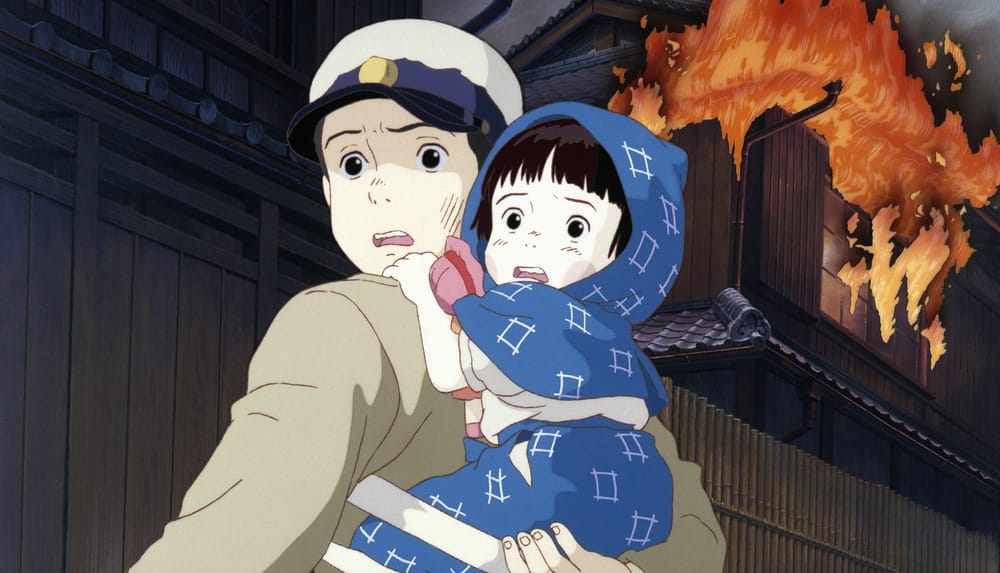Rethinking the War Narrative with Grave of the Fireflies
by Blair E. Vandehey
To the janitors of Kobe’s Sannomiya train station, Seita’s (Tsutomu Tatsumi) body is just more collateral of post-World War Two Japan’s food shortages to clean up. Just waiting for him on the other side is his late little sister Setsuko (Ayano Shiraishi). Finally having been reunited, the two spirits board the empty departing train. Based on a semi-autobiographical short story by Akiyuki Nosaka, Isao Takahata’s 1998 Grave of the Fireflies revisits the world they experienced in the final months of the war—their last summer together.
Considered by some to be “Japan’s Disney,” Ghibli films have seen their fair share of monsters: the scrambling sootballs of Spirited Away to fiery friends hungry for kindling in Howl’s Moving Castle to the curious forest spirit Totoro. In Grave of the Fireflies, however, ‘monstrous’ means something far different; the inhumanity that Seita and Setsuko face is, rather, the brutality of war. Almost immediately, the siblings’ world is thrown upside-down when their town is leveled in a firebombing, disfiguring and killing their mother and leaving the children orphans. Needless to say, the film does not fall into the trap of romanticizing war as many other works do. Instead, they expose (in a raw but deeply respectful manner) the harrowing effects of malnourishment as Setsuko slowly loses her strength, poverty driving a desperate Seita to steal from people’s abandoned houses during air raids despite the grave danger it puts him in, and the people around them becoming desensitized to the siblings’ struggle, too focused on their own fight to survive. Especially because we see these events play out in a style so closely associated with magic, adventure, and fun makes Grave of the Fireflies’ rawness nothing short of jarring.
The film would not have been half as heart-wrenching as it was without Takahata opening it with Seita and Setsuko having already passed. With this knowledge given immediately to the viewer, we are made aware of what will happen even before the story begins. As the tale plays out, we can only watch on with this ominous cloud of knowledge hanging over our heads, the siblings’ tribulations become even more desolate–we know there is nothing that can happen to prevent these events leading up to the end. Rather than focusing on what happens in the end, Takahata instead makes us greatly aware of how we reach this end – the brutal realities of war.
Seita and Setsuko are not the typical protagonists of a war film; oftentimes, we experience the conflict through the eyes of those on the front lines. However, our main characters are rural civilians far away from the fighting. Thus, viewers are entreated to a far different perspective than what is expected of the genre; though they never experience war firsthand, the siblings face different but equally-real effects of war, such as shortages, displacement, and separation from family. Similarly, the movie does not end when the war does like many others do – we do not even learn the war has ended until Seita overhears people mention offhandedly in the line at a bank. Just because the fighting is over does not mean that all is well, and Grave of the Fireflies recognizes this well in the siblings’ continued starvation even after Japan’s surrender.
One other quality of our protagonists sticks out as unique; they are children, Setsuko being only four and Seita in his early teens. Setsuko seems to understand that bad things are happening but cannot grasp the full gravity of their situation. On the flipside, Seita, barely on the cusp of adulthood, is forced to ‘grow up’ in order to keep his little sister safe. Their different reactions are best seen in the scene where their mother dies; Setsuko does not understand why she cannot visit her mother after the firebombing and Seita grimly understands that he now must shoulder complete responsibility for Setsuko as her older brother. Throughout the movie, their status as innocent (or as innocent as they can be with everything they experience) children is juxtaposed with the horrors of war. Scenes of the two laughing as they chase fireflies parallel those in which they make a break for cover from airstrikes. These childlike moments stand out starkly against the rest of the movie; we must remember that although the two are constantly working towards supporting themselves, they are still just children at heart.
To this day, there is not another Studio Ghibli movie quite like Takahata’s Grave of the Fireflies. While the film concludes with Seita and Setsuko’s ghosts overlooking modern-day Kobe, its anti-war message, powerful cinematic choices, and unique presentation still resonate with audiences worldwide.




